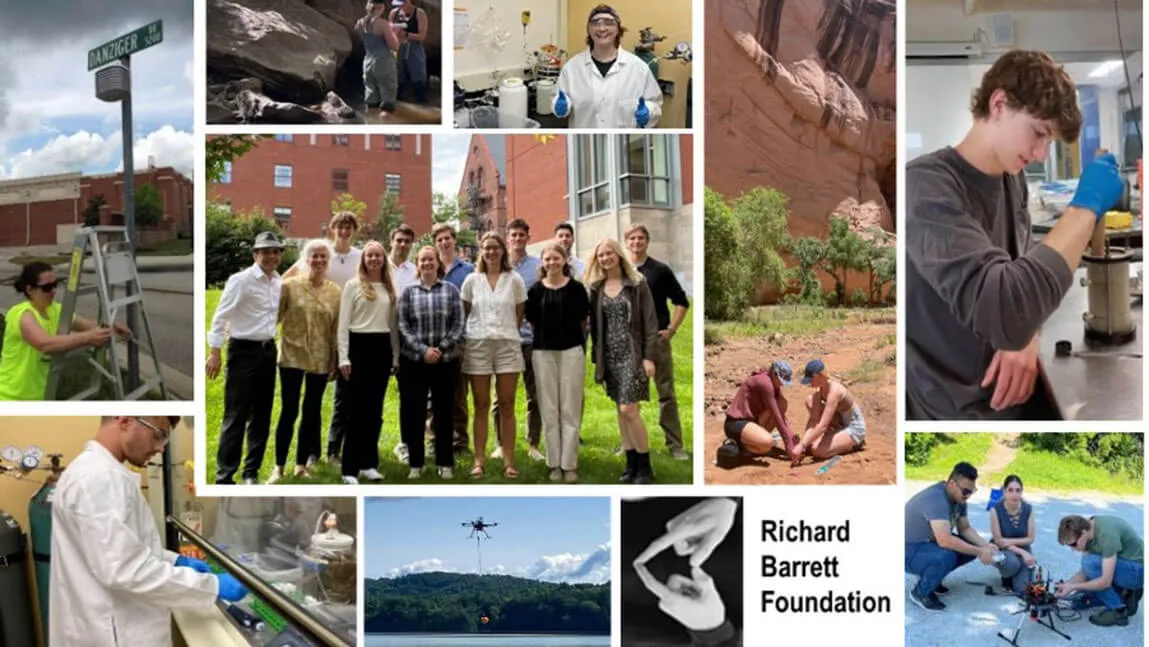This past summer, nine engineering students—Zai Gluck, Emily Hall, Agusten Hoen, Ben Mays, Luca Mossman, Charlotte Perveiler, Cooper Petrie, Perry Wilson, and Lauren Waters—were provided prestigious awards through the Richard Barrett Scholars program to pursue independent research under the guidance of faculty mentors.
A 1966 graduate of UVM’s mechanical engineering program, Richard Barrett has always been grateful for his undergraduate internship experience and has, through the Barrett Foundation, supported a generous summer research internship program for undergraduate engineering students in the College of Engineering and Mathematical Sciences (CEMS) to pursue research that promotes environmental stewardship.
This year’s student scholars came from civil, electrical, environmental, and mechanical engineering. Their internships explored a diverse spectrum of research: from mapping the hydrology of Arizona’s Canyon de Chelly in support of archeological site preservation; to using remote sensing technology to estimate evapotranspiration; to studying urban heat island effects; to developing sustainable methods for dairy waste management and anaerobic digestion of food waste; to catalyzing the use of recycled glass in construction; to developing drones for senor/sampling deployments on landslides and water quality monitoring.
Mentored by their research faculty advisors, the students were also advised and supported by graduate students, other faculty, and national and state agencies. Before starting their internships, the students participated in workshops on research methods and communications taught by Professors Luis Garcia, Donna Rizzo and Mandar Dewoolkar, Barrett Foundation Director Magdalena Paul, and doctoral students Kate Porterfield and Ryan van der Heijden whose fellowships program in the College of Engineering and Mathematical Sciences and the Gund Institute for Environment are also supported by the Barrett Foundation.
Structured to reflect the application process and execution of a program that would typically be funded by an external granting agency, the students were required to submit an application which was then evaluated by a panel of CEMS faculty before the top-ranked proposals were selected for funding.
Several of the students who received funding for internships this past year shared their experiences:
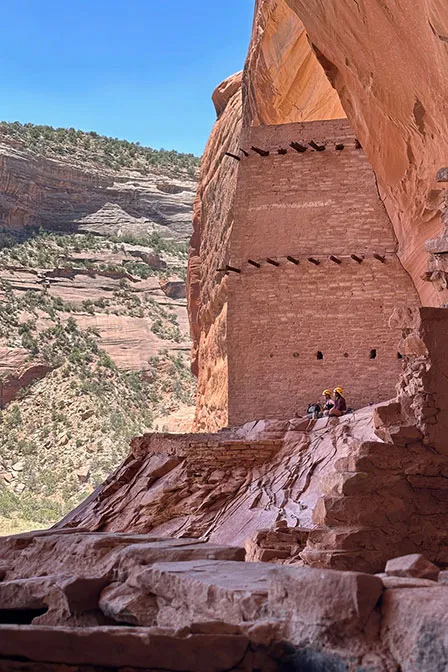
Emily Hall ‘24, Environmental Engineering
Research Project: Mapping the Hydrology of Canyon de Chelly in Support of Archaeological Site Preservation?
Faculty Mentor: Dr. Donna Rizzo and Dr. Arne Bomblies
Where did you intern: Burlington, VT and Chinle, AZ
Describe the research project you participated in: My research project focused on the issue of increased erosion at ancient sites in the National Monument and involved placing water level sensors in Canyon de Chelly to gain volumetric measurements of flash flood flows in the canyon. The end goal is to develop an accurate hydrological model of the area to better predict future flows and the potential for damage to the sites. The project involved research professors from the University of Vermont, the University of New Mexico, and the National Park Service.
What was your role: My role in the project was to place and secure sensors during a site visit, make observations and track GPS and elevation points, work with the archaeologists to determine their needs, and begin the hydrological model. I was lucky to have the new experience of participating in fieldwork in a remote location, working with new types of people including on-the-ground people from the National Park Service, and learning more technical skills.
How did this opportunity impact your studies at UVM? This opportunity helped me get involved in other similar research projects at UVM and allowed me to make additional connections with graduate students and faculty.
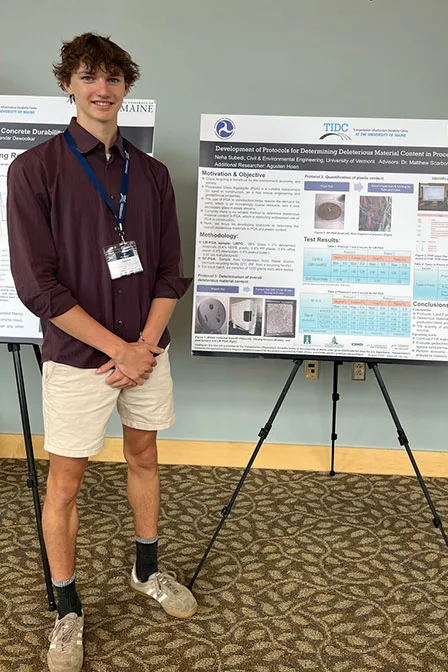
Agusten Hoen ‘25, General Engineering
Research Project: Can crushed recycled glass be substituted for extracted sand borrow, a resource that is fast depleting?
Faculty Mentor: Mandar Dewoolkar and Matthew Scarborough
Where did you intern: University of Vermont
Describe the research project you participated in: This research project consisted of developing operationally reliable methods for quantifying deleterious material content and plastic content in Processed Glass Aggregate (PGA) and running laboratory tests to compare the geotechnical properties of Processed Glass Aggregate and sand borrow.
What was your role: I worked with graduate student Neha Subedi on daily basis. Specifically, I performed two different protocols to determine the quantity of deleterious material content and plastic content in Processed Aggregate. I also conducted the Direct Shear Test and Constant Head Permeability Test to compare the shear strength and permeability of processed glass aggregate and sand borrow, respectively, to assess if the processed glass aggregate can substitute sand borrow.
How did this opportunity impact your studies at UVM? This opportunity gave me valuable experience in the process of research and provided me with an understanding of how a university curriculum applies to real-world problems. I was able to participate in the project’s technical advisory committee meeting with people from the Vermont Agency of Transportation, Vermont Agency of Natural Resources, and Chittenden Solid Waste District. I was also given the opportunity to attend a conference held at the Transportation Infrastructure Durability Center at the University of Maine. I am continuing this research in the fall through the College’s REU program.
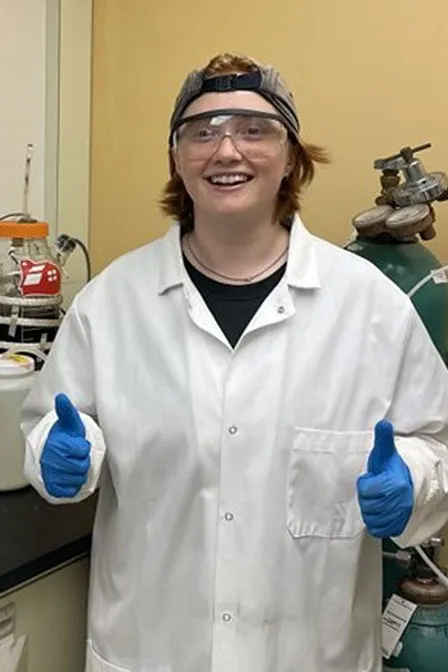
Perry Wilson ‘24, Environmental Engineering
Research Project: Investigating the conversion of wastewater from Cabot Creamery into beneficial products.
Faculty Mentor: Matthew Scarborough
Where did you intern: The Environmental Microbiome Engineering Group (EMERG)
Describe the research project you participated in: I assisted graduate student Kennedy Brown on a thesis project that was aimed at creating a closed-loop system for dairy waste products. In this case, wastewater from Cabot Creamery was characterized and placed in two bench-scale bioreactors (AD and AnMBR) to assess the viability of anaerobic digestion as a treatment option. Anaerobic digestion allows microbes to break down organic matter to produce methane and extract nutrients from waste products. I focused on the nutrient recovery side in this project, and I am assessing if struvite (a crystal that can be used as fertilizer) can be precipitated from the AnMBR effluent.
What was your role: I assisted Kennedy on the core project and launched a side project as well. I carried out testing COD, phosphate, and ammonia to characterize the wastewater and the resulting effluent products from the bioreactors.
How did this opportunity impact your studies at UVM? This opportunity allowed me to join a research group and then continue that research through the REU program after the summer. This has also helped steer my career interests as I am thinking about getting my master's degree after graduation. Having done some undergraduate research, I now feel more confident in my ability to design experiments, conduct research, and communicate my findings.
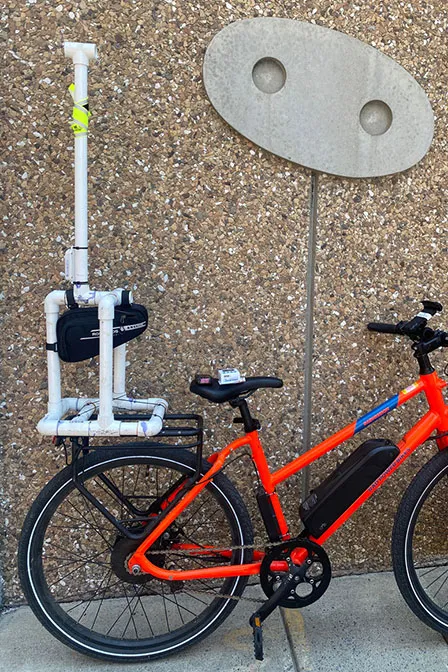
Lauren Waters ‘25, Environmental Engineering
Research Project: Measuring Urban Heat Islands in Small Cities in Vermont.
Faculty Mentor: Elizabeth Doran
Where did you intern: UVM Transportation Research Center
Describe the research project you participated in: I Researched the presence of urban heat islands (UHI) in small cities. Current research predominantly focuses on large metropolitan areas, although a third of the US population lives in small and medium-sized cities which have unique vulnerabilities and limited resources available to address the challenge of extreme heat and UHI mitigation.
What was your role: I worked within the UVM Transportation Research Center (TRC) to collect and analyze weather data from stationary, mobile, and remote sensors across seven small cities in Vermont to determine if the urban heat island effect is present. Using R software to model findings, I positively concluded the presence of the effect by comparing the temperature and relative humidity of downtown urban locations, neighborhood locations, and rural locations. In addition, I helped expand the UVM TRC database by collecting temperature and relative humidity data on an e-bike in Burlington, VT.
How did this opportunity impact your studies at UVM? This opportunity offered a unique and hands-on experience in investigating the presence of UHI in small cities. I was able to apply what I have learned in classes at UVM to real-world situations. It has enhanced my understanding of data collection methods and statistical analysis. The research has broadened my perspective on urban planning and environmental challenges and has helped me discover my passion for environmental engineering. I am grateful to have contributed to meaningful research efforts within the university.
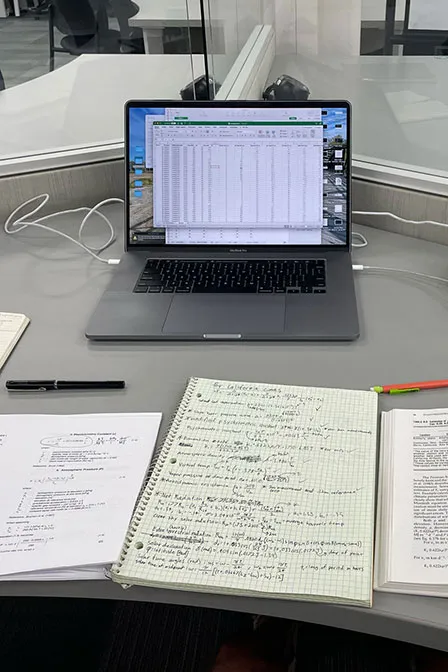
Cooper Petrie ‘25, Environmental Engineering
Research Project: Using Spatial Information and Remote Sensing to Estimate Water Use and Evapotranspiration?
Faculty Mentor: Luis Garcia
Where did you intern: University of Vermont
Describe the research project you participated in: My research project involved using two different methods for predicting evapotranspiration (ET) for different projects and analyzing their performance. One method used ground data and numerical methods which took longer because I had to research what parts of the equations would be most appropriate for my situation. After trial and error, I used the Penman-Monteith equation. This was implemented on a research farm in Pennsylvania to help AI predict crop yields. I also used remote sensing with data from OpenET and the LandSat Satellites from an API and implemented this on the Pennsylvania farm. However, this method was better suited to predicting water budgets for the year in Canyon de Chelly to help better predict flood and erosion patterns.
What was your role: I created the ET models for all methods at all locations, which included doing a lot of research for ET equations and meant a lot of trial and error. I was also responsible for receiving all the data and interpreting it. Once I got the equation working, I had to decide the best way to display it and I had to compare this with the remotely sensed data. I was responsible for getting the remotely sensed data and making images and statistical tests on it. I had a lot of freedom and control over this project but the only thing that I did not do was write the code for the API to cut and change the raster data.
How did this opportunity impact your studies at UVM? This opportunity made me resilient and develop a good work ethic. Through trial and error, I developed a deeper understanding of how remote sensing works with satellites and the inner workings of ArcMAP. This experience also refined my presentation skills and I have since implemented them in most of my classes. I am also a Teaching assistant (TA) for Dr. Garcia's Geomatics class because I now have a deeper understanding of satellite mapping.
